
Jeannette Pickering Rankin was an American politician and women's rights advocate who became the first woman to hold federal office in the United States. She was elected to the U.S. House of Representatives as a Republican from Montana in 1916 for one term, then was elected again in 1940. Rankin remains the only woman ever elected to Congress from Montana.
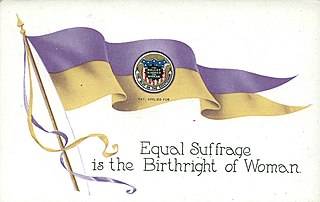
The National American Woman Suffrage Association (NAWSA) was an organization formed on February 18, 1890, to advocate in favor of women's suffrage in the United States. It was created by the merger of two existing organizations, the National Woman Suffrage Association (NWSA) and the American Woman Suffrage Association (AWSA). Its membership, which was about seven thousand at the time it was formed, eventually increased to two million, making it the largest voluntary organization in the nation. It played a pivotal role in the passing of the Nineteenth Amendment to the United States Constitution, which in 1920 guaranteed women's right to vote.
This timeline highlights milestones in women's suffrage in the United States, particularly the right of women to vote in elections at federal and state levels.

Women's suffrage was established in the United States on a full or partial basis by various towns, counties, states and territories during the latter decades of the 19th century and early part of the 20th century. As women received the right to vote in some places, they began running for public office and gaining positions as school board members, county clerks, state legislators, judges, and, in the case of Jeannette Rankin, as a member of Congress.
The Maryland Woman Suffrage Association (MWSA) was a woman's suffrage organization in Maryland, USA, founded in 1889.
The fight for women's suffrage in New Mexico was incremental and had the support of both Hispanic and Anglo women suffragists. When New Mexico was a territory, women had the right to vote in school board elections. When New Mexico created its state constitution in 1910, it continued to allow women to vote in school elections, but it was nearly impossible to modify the constitution for suffrage any further. Women in the state chose to pursue advocating for a federal women's suffrage amendment. They organized among both English and Spanish speaking groups. Many New Mexico politicians supported suffrage on a federal level. Continued advocacy on behalf of suffragists in the state allowed New Mexico to become the 32nd state to ratify the Nineteenth Amendment on February 21, 1920.

This is a timeline of women's suffrage in Montana. The fight for women's suffrage in Montana started early, before Montana became a state. In 1887, women gained the right to vote in school board elections and on tax issues. In the years that followed, women battled for full, equal suffrage, which culminated in a year-long campaign in 1914 when they became one of eleven states with equal voting rights for most women. Montana ratified the Nineteenth Amendment on August 2, 1919 and was the thirteenth state to ratify. Native American women voters did not have equal rights to vote until 1924.

The first women's suffrage group in Georgia, the Georgia Woman Suffrage Association (GWSA), was formed in 1892 by Helen Augusta Howard. Over time, the group, which focused on "taxation without representation" grew and earned the support of both men and women. Howard convinced the National American Women's Suffrage Association (NAWSA) to hold their first convention outside of Washington, D.C., in 1895. The convention, held in Atlanta, was the first large women's rights gathering in the Southern United States. GWSA continued to hold conventions and raise awareness over the next years. Suffragists in Georgia agitated for suffrage amendments, for political parties to support white women's suffrage and for municipal suffrage. In the 1910s, more organizations were formed in Georgia and the number of suffragists grew. In addition, the Georgia Association Opposed to Woman Suffrage also formed an organized anti-suffrage campaign. Suffragists participated in parades, supported bills in the legislature and helped in the war effort during World War I. In 1917 and 1919, women earned the right to vote in primary elections in Waycross, Georgia and in Atlanta respectively. In 1919, after the Nineteenth Amendment went out to the states for ratification, Georgia became the first state to reject the amendment. When the Nineteenth Amendment became the law of the land, women still had to wait to vote because of rules regarding voter registration. White Georgia women would vote statewide in 1922. Native American women and African-American women had to wait longer to vote. Black women were actively excluded from the women's suffrage movement in the state and had their own organizations. Despite their work to vote, Black women faced discrimination at the polls in many different forms. Georgia finally ratified the Nineteenth Amendment on February 20, 1970.
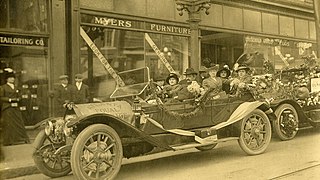
This is a timeline of women's suffrage in Georgia. Women's suffrage in Georgia started in earnest with the formation of the Georgia Woman Suffrage Association (GWSA) in 1892. GWSA helped bring the first large women's rights convention to the South in 1895 when the National American Woman's Suffrage Association (NAWSA) held their convention in Atlanta. GWSA was the main source of activism behind women's suffrage until 1913. In that year, several other groups formed including the Georgia Young People's Suffrage Association (GYPSA) and the Georgia Men's League for Woman Suffrage. In 1914, the Georgia Association Opposed to Women's Suffrage (GAOWS) was formed by anti-suffragists. Despite the hard work by suffragists in Georgia, the state continued to reject most efforts to pass equal suffrage. In 1917, Waycross, Georgia allowed women to vote in primary elections and in 1919 Atlanta granted the same. Georgia was the first state to reject the Nineteenth Amendment. Women in Georgia still had to wait to vote statewide after the Nineteenth Amendment was ratified on August 26, 1920. Native American and African American women had to wait even longer to vote. Georgia ratified the Nineteenth Amendment in 1970.

Women's suffrage began in Illinois began in the mid-1850s. The first women's suffrage group was formed in Earlville, Illinois, by the cousin of Susan B. Anthony, Susan Hoxie Richardson. After the Civil War, former abolitionist Mary Livermore organized the Illinois Woman Suffrage Association (IWSA), which would later be renamed the Illinois Equal Suffrage Association (IESA). Frances Willard and other suffragists in the IESA worked to lobby various government entities for women's suffrage. In the 1870s, women were allowed to serve on school boards and were elected to that office. The first women to vote in Illinois were 15 women in Lombard, Illinois, led by Ellen A. Martin, who found a loophole in the law in 1891. Women were eventually allowed to vote for school offices in the 1890s. Women in Chicago and throughout Illinois fought for the right to vote based on the idea of no taxation without representation. They also continued to expand their efforts throughout the state. In 1913, women in Illinois were successful in gaining partial suffrage. They became the first women east of the Mississippi River to have the right to vote in presidential elections. Suffragists then worked to register women to vote. Both African-American and white suffragists registered women in huge numbers. In Chicago alone 200,000 women were registered to vote. After gaining partial suffrage, women in Illinois kept working towards full suffrage. The state became the first to ratify the Nineteenth Amendment, passing the ratification on June 10, 1919. The League of Women Voters (LWV) was announced in Chicago on February 14, 1920.
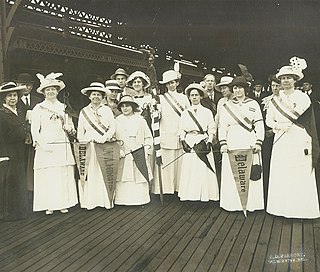
Women's suffrage began in Delaware the late 1860s, with efforts from suffragist, Mary Ann Sorden Stuart, and an 1869 women's rights convention held in Wilmington, Delaware. Stuart, along with prominent national suffragists lobbied the Delaware General Assembly to amend the state constitution in favor of women's suffrage. Several suffrage groups were formed early on, but the Delaware Equal Suffrage Association (DESA) formed in 1896, would become one of the major state suffrage clubs. Suffragists held conventions, continued to lobby the government and grow their movement. In 1913, a chapter of the Congressional Union (CU), which would later be known at the National Woman's Party (NWP), was set up by Mabel Vernon in Delaware. NWP advocated more militant tactics to agitate for women's suffrage. These included picketing and setting watchfires. The Silent Sentinels protested in Washington, D.C., and were arrested for "blocking traffic." Sixteen women from Delaware, including Annie Arniel and Florence Bayard Hilles, were among those who were arrested. During World War I, both African-American and white suffragists in Delaware aided the war effort. During the ratification process for the Nineteenth Amendment, Delaware was in the position to become the final state needed to complete ratification. A huge effort went into persuading the General Assembly to support the amendment. Suffragists and anti-suffragists alike campaigned in Dover, Delaware for their cause. However, Delaware did not ratify the Nineteenth Amendment until March 6, 1923, well after it was already part of the United States Constitution.
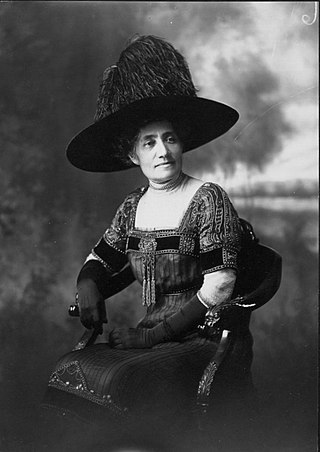
Women's suffrage began in Hawaii in the 1890s. However, when the Hawaiian Kingdom ruled, women had roles in the government and could vote in the House of Nobles. After the overthrow of Queen Liliʻuokalani in 1893, women's roles were more restricted. Suffragists, Wilhelmine Kekelaokalaninui Widemann Dowsett and Emma Kaili Metcalf Beckley Nakuina, immediately began working towards women's suffrage. The Women's Christian Temperance Union (WCTU) of Hawaii also advocated for women's suffrage in 1894. As Hawaii was being annexed as a US territory in 1899, racist ideas about the ability of Native Hawaiians to rule themselves caused problems with allowing women to vote. Members of the National American Woman Suffrage Association (NAWSA) petitioned the United States Congress to allow women's suffrage in Hawaii with no effect. Women's suffrage work picked up in 1912 when Carrie Chapman Catt visited Hawaii. Dowsett created the National Women's Equal Suffrage Association of Hawai'i that year and Catt promised to act as the delegate for NAWSA. In 1915 and 1916, Prince Jonah Kūhiō Kalanianaʻole brought resolutions to the U.S. Congress requesting women's suffrage for Hawaii. While there were high hopes for the effort, it was not successful. In 1919, suffragists around Hawaii met for mass demonstrations to lobby the territorial legislature to pass women's suffrage bills. These were some of the largest women's suffrage demonstrations in Hawaii, but the bills did not pass both houses. Women in Hawaii were eventually franchised through the passage of the Nineteenth Amendment.
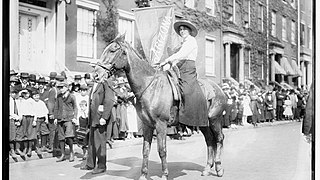
The movement for women's suffrage in Arizona began in the late 1800s. After women's suffrage was narrowly voted down at the 1891 Arizona Constitutional Convention, prominent suffragettes such as Josephine Brawley Hughes and Laura M. Johns formed the Arizona Suffrage Association and began touring the state campaigning for women's right to vote. Momentum built throughout the decade, and after a strenuous campaign in 1903, a woman's suffrage bill passed both houses of the legislature but was ultimately vetoed by Governor Alexander Oswald Brodie.

This is a timeline of women's suffrage in Arizona. The first women's suffrage bill was brought forward in the Arizona Territorial legislature in 1883, but it did not pass. Suffragists work to influence the Territorial Constitutional Convention in 1891 and lose the women's suffrage battle by only three votes. That year, the Arizona Suffrage Association is formed. In 1897, taxpaying women gain the right to vote in school board elections. Suffragists both from Arizona and around the country continue to lobby the territorial legislature and organize women's suffrage groups. In 1903, a women's suffrage bill passes, but is vetoed by the governor. In 1910, suffragists work to influence the Arizona State Constitutional Convention, but are also unsuccessful. When Arizona becomes a state on February 14, 1912, an attempt to legislate a women's suffrage amendment to the Arizona Constitution fails. Frances Munds mounts a successful ballot initiative campaign. On November 5, 1912, women's suffrage passes in Arizona. In 1913, the voter registration books are opened to women. In 1914, women participate in their first primary elections. Arizona ratified the Nineteenth Amendment on February 12, 1920. However, Native American women and Latinas would wait longer for full voting rights.

This is a timeline of women's suffrage in Maine. Suffragists began campaigning in Maine in the mid 1850s. A lecture series was started by Ann F. Jarvis Greely and other women in Ellsworth, Maine in 1857. The first women's suffrage petition to the Maine Legislature was sent that same year. Women continue to fight for equal suffrage throughout the 1860s and 1870s. The Maine Woman Suffrage Association (MWSA) is established in 1873 and the next year, the first Woman's Christian Temperance Union (WCTU) chapter was started. In 1887, the Maine Legislature votes on a women's suffrage amendment to the state constitution, but it does not receive the necessary two-thirds vote. Additional attempts to pass women's suffrage legislation receives similar treatment throughout the rest of the century. In the twentieth century, suffragists continue to organize and meet. Several suffrage groups form, including the Maine chapter of the College Equal Suffrage League in 1914 and the Men's Equal Suffrage League of Maine in 1914. In 1917, a voter referendum on women's suffrage is scheduled for September 10, but fails at the polls. On November 5, 1919 Maine ratifies the Nineteenth Amendment. On September 13, 1920, most women in Maine are able to vote. Native Americans in Maine are barred from voting for many years. In 1924, Native Americans became American citizens. In 1954, a voter referendum for Native American voting rights passes. The next year, Lucy Nicolar Poolaw (Penobscot), is the Native American living on an Indian reservation to cast a vote.

While women's suffrage had an early start in Maine, dating back to the 1850s, it was a long, slow road to equal suffrage. Early suffragists brought speakers Susan B. Anthony and Lucy Stone to the state in the mid-1850s. Ann F. Jarvis Greely and other women in Ellsworth, Maine, created a women's rights lecture series in 1857. The first women's suffrage petition to the Maine Legislature was also sent that year. Working-class women began marching for women's suffrage in the 1860s. The Snow sisters created the first Maine women's suffrage organization, the Equal Rights Association of Rockland, in 1868. In the 1870s, a state suffrage organization, the Maine Women's Suffrage Association (MWSA), was formed. Many petitions for women's suffrage were sent to the state legislature. MWSA and the Woman's Christian Temperance Union (WCTU) of Maine worked closely together on suffrage issues. By the late 1880s the state legislature was considering several women's suffrage bills. While women's suffrage did not pass, during the 1890s many women's rights laws were secured. During the 1900s, suffragists in Maine continued to campaign and lecture on women's suffrage. Several suffrage organizations including a Maine chapter of the College Equal Suffrage League and the Men's Equal Rights League were formed in the 1910s. Florence Brooks Whitehouse started the Maine chapter of the National Woman's Party (NWP) in 1915. Suffragists and other clubwomen worked together on a large campaign for a 1917 voter referendum on women's suffrage. Despite the efforts of women around the state, women's suffrage failed. Going into the next few years, a women's suffrage referendum on voting in presidential elections was placed on the September 13, 1920 ballot. But before that vote, Maine ratified the Nineteenth Amendment on November 5, 1920. It was the nineteenth state to ratify. A few weeks after ratification, MWSA dissolved and formed the League of Women Voters (LWV) of Maine. White women first voted in Maine on September 13, 1920. Native Americans in Maine had to wait longer to vote. In 1924, they became citizens of the United States. However, Maine would not allow individuals living on Indian reservations to vote. It was not until the passage of a 1954 equal rights referendum that Native Americans gained the right to vote in Maine. In 1955 Lucy Nicolar Poolaw (Penobscot) was the first Native American living on a reservation in Maine to cast a vote.

Attempts to secure women's suffrage in Wisconsin began before the Civil War. In 1846, the first state constitutional convention delegates for Wisconsin discussed women's suffrage and the final document eventually included a number of progressive measures. This constitution was rejected and a more conservative document was eventually adopted. Wisconsin newspapers supported women's suffrage and Mathilde Franziska Anneke published the German language women's rights newspaper, Die Deutsche Frauen-Zeitung, in Milwaukee in 1852. Before the war, many women's rights petitions were circulated and there was tentative work in forming suffrage organizations. After the Civil War, the first women's suffrage conference held in Wisconsin took place in October 1867 in Janesville. That year, a women's suffrage amendment passed in the state legislature and waited to pass the second year. However, in 1868 the bill did not pass again. The Wisconsin Woman Suffrage Association (WWSA) was reformed in 1869 and by the next year, there were several chapters arranged throughout Wisconsin. In 1884, suffragists won a brief victory when the state legislature passed a law to allow women to vote in elections on school-related issues. On the first voting day for women in 1887, the state Attorney General made it more difficult for women to vote and confusion about the law led to court challenges. Eventually, it was decided that without separate ballots, women could not be allowed to vote. Women would not vote again in Wisconsin until 1902 after separate school-related ballots were created. In the 1900s, state suffragists organized and continued to petition the Wisconsin legislature on women's suffrage. By 1911, two women's suffrage groups operated in the state: WWSA and the Political Equality League (PEL). A voter referendum went to the public in 1912. Both WWSA and PEL campaigned hard for women's equal suffrage rights. Despite the work put in by the suffragists, the measure failed to pass. PEL and WWSA merged again in 1913 and women continued their education work and lobbying. By 1915, the National Woman's Party also had chapters in Wisconsin and several prominent suffragists joined their ranks. The National Woman Suffrage Association (NAWSA) was also very present in Wisconsin suffrage efforts. Carrie Chapman Catt worked hard to keep Wisconsin suffragists on the path of supporting a federal woman's suffrage amendment. When the Nineteenth Amendment went out to the states for ratification, Wisconsin an hour behind Illinois on June 10, 1919. However, Wisconsin was the first to turn in the ratification paperwork to the State Department.

Women's suffrage started in South Dakota when it was part of Dakota Territory. Prior to 1889, it had a shared history of women's suffrage with North Dakota. While South Dakota was part of the territory, women earned the right to vote on school related issues. They retained this right after it became a separate state. The state constitution specified that there would be a women's suffrage amendment referendum in 1890. Despite a large campaign that included Susan B. Anthony and a state suffrage group, the South Dakota Equal Suffrage Association (SDESA), the referendum failed. The state legislature passed additional suffrage referendums over the years, but each was voted down until 1918. South Dakota was an early ratifier of the Nineteenth Amendment, which was approved during a special midnight legislative session on December 4, 1919.

This is a timeline of women's suffrage in South Dakota. The early history of women's suffrage in the state is shared with North Dakota. When South Dakota became a state, it held a voter referendum in 1890 on an equal suffrage amendment. This effort failed, but suffragists continued to organize and lobby the legislature to pass voter referendums. None passed until 1918. South Dakota ratified the Nineteenth Amendment on December 4, 1919.



















